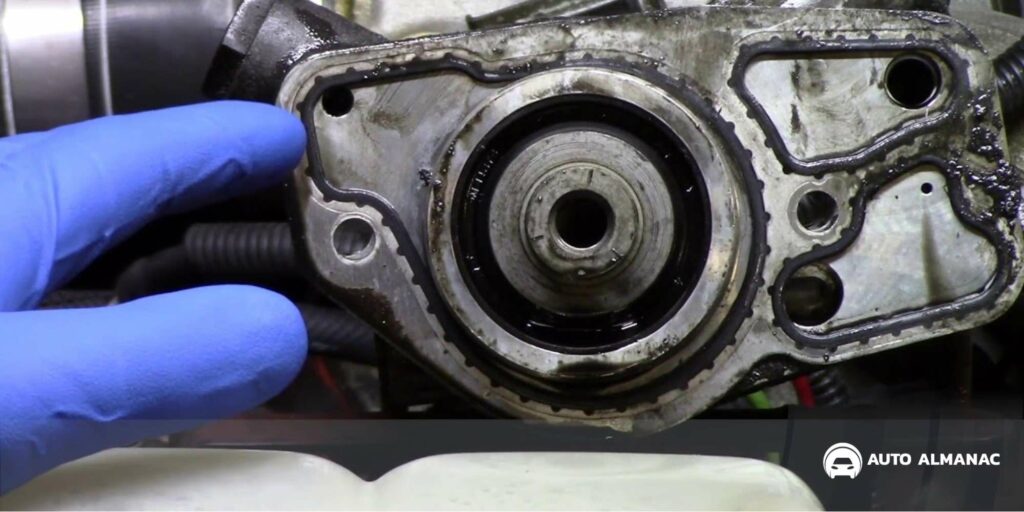
High-pressure oil pump (HPOP) symptoms are notoriously difficult to spot early because they tend to be subtle or intermittent and can point toward various other problems.
The most common 7.3 Powerstroke high-pressure oil pump symptoms include oil pressure warning lights, troubled noises, blue smoke, long crank times, and loss of power at higher RPMs.
These also include overheating issues, oil deposits on the fuel filter and the engine valley, high exhaust temperatures, and the P1211 DTC.
It’s better to park the car immediately as driving with these symptoms is rather risky.
The lack of pressure could result in the car failing to drive the camshaft and thus leaving you stranded with comparably higher repair bills that need paying in addition to potentially destroying the engine.
Replacing the HPOP yourself is both difficult and dangerous if you don’t possess the skills and experience needed. The costs are fairly high as HPOP replacements tend to cost a thousand or two at least.
You should first try and rebuild the HPOP. If that fails, only then you should proceed toward replacing it.
All in all, the inspection and the replacement are sure to take a few hours. If you want to know more about these symptoms and how you can get rid of them, be sure to read this article and find out!

7.3 Powerstroke High Pressure Oil Pump or HPOP Symptoms?
The symptoms of a failing HPOP are:
- Oil Pressure Warning Light
- Whining or Whirring Noise from the Engine
- Blue Smoke from the Exhaust
- Unusually Long Crank Time
- Losing Power at High RPMs
- Overheating Engine
- Oil Deposits on the Fuel Filter
- High Exhaust Gas Temperature
- Oil Deposits in the Engine Valley
- P1211 Code
Oil Pressure Warning Light

The oil pressure warning light comes on when the car’s Powertrain Control Module (PCM) deems that the oil pressure within your engine is either too high or too low.
As oil is arguably the most essential of all car fluids, you need to take this warning light seriously.
Why is my oil light on?
- A faulty sensor
- Low oil levels
- A damaged/faulty oil pump
If the high-pressure oil pump fails to pump the oil at an appropriate pressure, the light is going to come and is likely to be followed by some of the other symptoms on this list.
Whining or Whirring Noise From the Engine
A sound of a diesel engine is rather unmistakable as some find it harmonious while others find it way too agricultural for a road vehicle. Either way, it’s easy to tell when a diesel engine sounds troubled.
If you hear any whining and/or whirring noises coming from the engine bay, especially under acceleration, your high-pressure oil pump might be declining rapidly.
We already mentioned that the oil pump is mated to the camshaft. As the camshaft rotates quicker and quicker (during acceleration), the pump needs to work harder and harder and thus the noise becomes more noticeable.
Blue Smoke from the Exhaust

Motor oil is essential for the inner workings of an engine, but it was not designed to take part in the combustion process itself.
As such, if oil finds its way into the combustion chamber, it is going to burn and emit blue smoke from the exhaust. This is also followed by oil deposits on the very tips of the exhaust pipe.
If too much oil finds its way into the engine and causes the engine to starve, your engine could fail completely.
Unusually Long Crank Time
As a spot of context, a fully-functional, well-mannered diesel engine crank shouldn’t take more than a few seconds. If the outside temperature is really cold, this can be extended to about 5 seconds or so.
If the cranking process takes a few seconds longer than that, your engine could be suffering from oil pressure pump problems.
As both the oil and the engine are cold on startup, the oil is inherently able to transfer more energy, which means that the HPOP does not work as hard.
However, as the temperatures rise, the HPOP needs to work harder and harder which can also lead to the engine cutting off.
Losing Power at High RPMs
We already mentioned a few times that the HPOP oil works in conjunction with the camshaft while the camshaft is also directly linked to the accelerator pedal.
Whenever you increase your throttle input, the camshaft spins faster and thus the HPOP pushes more oil into the system.
However, if the HPOP struggles, you will feel a significant drop in power while pushing down on the accelerator pedal, no matter the fact that the RPMs keep climbing.
This works exponentially, which means the higher your RPMs, the more the oil pump struggles, and the more noticeable the power drops become.
Overheating Engine

Motor oil is tasked with a few essential missions, which are what make this fluid so precious. These are:
- Lubricating the engine
- Preventing corrosion
- Cleansing the engine
- Creating seals between the pistons and liner
- Cooling the engine down by carrying heat away from its internals
Therefore, if the amount of oil within the engine drops, all the excess heat will not be moved away from the engine and will likely lead to engine overheating.
Engine overheating can also be caused by problems with the car’s cooling system, so be sure to inspect the entire cooling system just to be sure.
| Overheating can be the end of an engine, which is why you should stop driving the car immediately after noticing the temperature gauge going up under normal load. |
Oil Deposits on the Fuel Filter

This symptom is rather difficult to spot on itself as diesel engines are typically known to burn oil without any obvious signs.
However, as the oil enters the combustion chamber and burns, some of the deposits tend to find their way onto the fuel filter.
So, if you suspect that your Powerstroke HPOP is faulty, be sure to check the fuel filter for any stains.
High Exhaust Gas Temperature
Measuring a car’s exhaust gas temperature can tell you many things about how your car burns fuel and air, how the injectors work, and if the EBP sensor is able to regulate the pressure.
However, if your Powerstroke is pushing more than 1250°F (676.7°C), even under heavy load, the problem could be caused by an HPOP if the rest of your fuel injection system is working appropriately.
Oil Deposits in the Engine Valley
Before going any further, we do need to mention that the HPOP isn’t necessarily a common place where a Powerstroke leaks oil. Most people misdiagnose this problem as a rear main seal leak.
Because of this, so be sure to check both.
How to Pinpoint an HPOP Leak
- Clean the Engine Valley Thoroughly
- Clean the HPOP Fittings Thoroughly
- Start the Truck and Rev It
- Inspect the Fittings and the Engine Valley
After carrying out this test, you should be able to notice oil leaks around the fittings or the drain plug if the HPOP is indeed leaking.
P1211 Diagnostic Trouble Code
No matter the problem you believe your car is suffering from, it’s always crucial to scan the car’s ECU for any diagnostic trouble codes as these can help you both narrow down the reasons and prevent misdiagnosis.
The P1211 code typically points toward a leak on either the HPOP ailment or the Injection Pressure Regulator (IPR), which controls the amount of oil the HPOP circulates.
How to Fix
After you familiarize yourself with all the symptoms of an HPOP problem, it’s time to fix it!
Inspect 7.3 High-Pressure Oil Pump
If some of these symptoms do take place, there is good reason to think that your HPOP is to blame. So, roll up your sleeves, find a diagnostics scan tool, and get to work!
Hook the Scan Tool Up to Your Vehicle’s OBD Connector
After plugging in the scan tool, now it’s time to move to the datastream device and find the associated data stream with the ICP mark.

Set the readings up to read PSI levels, and try to find an assistant to monitor the ICP data readings.
Go on an open stretch of road with little to no traffic (highway), and try to accelerate from around 50mph to at least 70mph (if the speed limit allows you to).
The ICP PSI readings are likely going to fluctuate between 2,800PSI and 3,000PSI while on full throttle, but will gradually stabilize on one particular reading.
| If the readings stabilize around 2,800 PSI (2,200 PSI – 2,600 PSI for older HPOPs), everything is fine. If the readings are under 2,200 PSI, your HPOP is faulty and will need immediate repair, rebuild, or complete replacement. |
Rebuild Your 7.3 High-Pressure Oil Pump
As the HPOP is notoriously expensive, opting to rebuild it could save you a few hundred bucks at the very least.
This is fairly common for a Powerstroke diesel engine as rebuilding these HPOPs is usually the first thing to do, especially if the HPOP isn’t all that old. To do so, you will need to get ahold of a so-called HPOP rebuild kit.
HPOP rebuild kits come with everything you need to rebuild your HPOP. These include:
- HPOP Fittings
- Drain Plug O-Rings
- IPR
- New Servicable Plugs
- Check Balls
To top it all off, you ought to secure your fittings with Loctite 680.
Remove & Replace the 7.3 High-Pressure Oil Pump
If the existing HPOP can’t be saved, is really old, or you want to fix this problem without worrying it will happen again anytime soon, you should replace the existing HPOP with a brand-new one.
How To Replace a 7.3 Powerstroke High-Pressure Oil Pump
- Remove the battery ground cables and the engine plastic cover
- Open and drain the fuel bowl by disconnecting the reservoir Allen 3/16 plug and removing it
- Drain all of the oil with a manual hand fluid pump
- Detach the four fuel lines away from the fuel bowl and from the fuel bowl connector
- Pull off the fuel drain valve and its sleeve, remove the EBP sensor and all of its sensor tubes
- Remove the fuel bowl and all of its hoses
- Detach and remove the IPR and its connector
- Slowly remove the HPOP front access plate and the drive gear bolt by unscrewing the two bolts that hold them together
- You should now be able to access the HPOP fully which means that you should slowly remove it and insert a new one
- To finish it all off, do all of these steps in reverse and finish installing your new HPOP
How much does it cost to replace a 7.3 Powerstroke oil pump?
The new HPOP is not a small investment, which means that the costs associated with replacing one are rather steep.
You can expect to pay between $1,400 and $2,000 for an HPOP replacement without including any other special parts.
However, there are many factors that can both increase or decrease those costs. For starters, if you live in an area where labor costs are higher, your final costs will follow.
Secondly, if this problem with the HPOP has caused other problems, chances are that you will have to buy additional parts to repair it all.
There were instances where people spent upwards of $4,000 for replacing the HPOP and all of the further damage it caused, especially if the engine was starved of oil for a long time.
How to Prevent HPOP Failure on 7.3 Powerstroke
Well, the main focus should always be thorough and timely maintenance, which means that you should look after your HPOP and always be on the lookout for any of the symptoms mentioned in this article.
Always remember to change your oil every 3,000 to 5,000 miles, which is also a good time to check your HPOP and all of its surrounding components for signs of leaks, damage, or any signs of performance defects.




